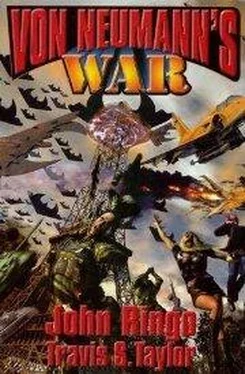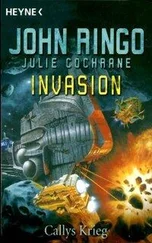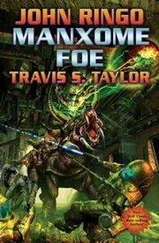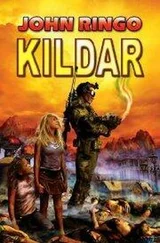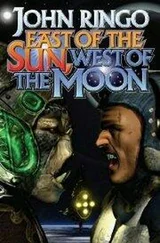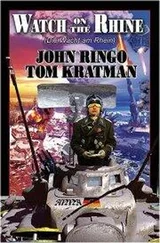The returns from Io and Europa couldn’t have been more conclusive. Among other things, Europa and Io both now had noticeable atmospheres; the halos were distinct in the image.
“You’re going to owe me a year’s salary,” Traci said, chortling quietly at the scientist’s disbelief. The current Io image was sharp enough that major features of the distant moon could be distinguished and it was apparent that the entire face had been radically altered. In fact, it looked as if one section had been deep strip-mined. For the change to be visible at this distance, even with the resolution of the Hubble, the structure had to be at a minimum four hundred kilometers across. The way things were going, the probes might just eat the moon.
“I think we should run a sharpening filter on the—” Roger said, reaching for the mouse on the image analysis computer.
“My job,” Traci said, slapping his hand aside. “You rocket scientists and telescope builders can’t do planetary measurements worth a flip. I’m not so sure the image can be any sharper. The aliasing seems to me to be due to being at the limit of the sensor’s resolution.”
“Traci dear, I’ve been analyzing IMINT imagery for more years than you’ve been in school,” he said.
“You’re not that old. And what’s mint imagery?”
“IMINT — it stands for ‘image intelligence.’ Astrophysicists.” Roger shook his head.
“Well, all I know is that the astronomical imagery data from the Hubble looked better before you ran that filter again.” She pointed at the now blotchy image on the monitor. Traci hit the undo button in the software menu to restore the image.
Traci had proven to be well worth her weight in gold. She had gotten in touch with the right people at the Space Telescope Science Institute and was trained on the Hubble-cycling protocols in just a few short days. She had gotten a lot of help from a fellow named Hamilton there. Jack Hamilton had been the first person to really detect the change in the Martian albedo and had been aware of the problem from the beginning. The STScI had been gagged by the President to keep the space telescope data quiet, so Jack and his professors had been briefed into the Neighborhood Watch from early on.
Traci had a command station set up in the HOSC at Huntsville and had it connected and encrypted through the program’s protocols. So between the folks at the STScI and the command station in Huntsville, the Hubble Space Telescope was being tasked one hundred percent by the Neighborhood Watch and Traci was doing the driving — with a little input from Jack and, of course, Roger.
She knew, more or less, what was going on at Saturn and its moons. Traci wasn’t quite sure what to make of the Titan data.
The moons of Uranus had similar changes. Ariel in particular had a surface albedo much greater than ever before measured. Likewise were the moons of Neptune. Triton specifically had obvious changes.
The albedos of the Kuiper Belt Objects including the Pluto-Charon system were harder to determine changes since there was less highly accurate albedo data available. However, some preliminary investigation suggested that Pluto was slightly brighter.
These experiments took the better part of the month following the Neighborhood Watch final report briefing to the White House. At the same time they’d gotten to work on Asymmetric Soldier.
Billions of dollars were pumped into the project in less than three months. The north Alabama Defense and Space industry infrastructure made a perfect central location for the AS project development and management. The first tactical and strategic suggestion developed from the project was to gather the nation’s space/defense talent at multiple locations across the country and in locations as fortified as possible. Asymmetric Soldier wings were set up at Cheyenne Mountain, in Wyoming, at a base in Montana, at Area 51 in Nevada, at Langley, Virginia, at CCAFS, at Vandenberg AFB in California, at Wright Patterson AFB in Ohio, at White Sands, Los Alamos, at Clear Lake City, Texas, at Whiteman AFB in Missouri, at the AFRL in Albuquerque, New Mexico, in two locations in Alaska, at Hickam AFB in Hawaii, at Thule AFB in Greenland, at the old Ramey AFB in Puerto Rico, and three U.S. Navy nuclear submarines and two aircraft carriers were designated as mobile research posts.
Thus far, with no actual data on the threat, AS was mostly spinning its wheels. With no better than the 20 meter resolution they’d gotten from Percival, they couldn’t even determine what the probes looked like. They could be some of the large structures they’d seen on Mars or they could be much smaller. The team had no idea how they moved, how they fought or how they thought. All they could do was look at current and projected military hardware and try to apply it to the little bit they did know. It was a frustrating process. And, deep in their bones, everyone on the team knew it was mostly a fruitless one as well.
The aliens were coming and nothing appeared capable of stopping them.
“Come in, Major Gries, I’m Alan Davis,” the scientist said, gripping Shane’s hand as he entered his office.
“You guys look busy,” Shane replied. The last time he’d been in Redstone was nearly four months before and it had seemed… sleepy compared to, say, the LockMart facility in Denver.
But from the careful inspection he’d been given at the main entrance to the repeated security checks he’d endured to get to the engineer’s office, the entire tenor of the base had changed. There were more people, all of them looking very distracted, and there was far more bustle. It looked more like a battalion getting ready to cross into “Indian Country” than a research base. And he’d seen signs of defensive emplacements under construction — berms being dug on the periphery of the base, construction on the hill that overlooked the Arsenal — that simply didn’t fit any scenario he could conceive. It looked as if the base was preparing for a siege. And finally, before Gries got any closer to knowing just what the hell was going on, he was asked to sign a shit-load of National Security Act paperwork.
“Okay, Major, you know all the secrecy stuff, I’m told,” Alan said, rolling his chair over to a coffee pot and pouring a cup. “You want?”
“Yes, sir, black, sir,” Shane answered.
“Siddown, and stop calling me sir. I’ve never been in the military, call me Alan — or Mr. Davis if you have to, but Alan is what I prefer,” Alan said, waving at a chair and pouring another cup into a none-too-clean mug. “What I’m about to tell you is going to break internationally sooner or later, but details are still going to be TS Special Access. Clear?”
“Yes, sir, uh, Mr. Davis,” Shane replied, taking the cup and a sip. The coffee was good at least. Whatever these eggheads had figured out, some congressman probably figured it would win him a whole hell of a lot of votes in the north Alabama district, because from the looks of things there was a lot of money being spent around town.
“About a year ago, people started to notice that the albedo of Mars, the light reflected from it, was changing.”
“The gray planet,” Shane said, nodding. “There was a news story about it and I saw some stuff online. But I didn’t really believe any of it. Sounded too much like UFO stuff to me.”
“Well, what is happening is…” Alan said, pausing as the door opened to admit a really good looking blonde. Blue eyes, curly hair, fine butt and tremendous knockers. She looked more like a Hooters waitress than an egghead, but Shane had met some fine looking eggheads over the last few months.
“Roger wanted you to see the changes on Mars and the new images of the Moon right away,” the girl said.
Читать дальше
